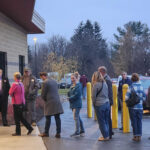
If you are interested in deer conservation, then this initiative is just for you. The 2021 deer initiative is focused on improving winter habitat conditions for white-tailed deer that occur within the northern limits of their range — Aroostook and Washington counties.
During harsh winters in northern Maine, deer must find mature forested habitat to survive. These forested stands, referred to as deer wintering areas (DWAs) or “deer yards,” contain mature conifer trees which are important for intercepting snowfall, reducing wind speeds and provide higher temperatures during the winter. The DWAs also provide quality food that help deer through stressful winter conditions. When DWAs are absent or not properly managed deer lose 10-20 percent of their body weight and over 40 percent is directly lethal and/or adversely affects fawn recruitment. In Aroostook and Washington counties deer may depend on the shelter and forage availability of DWAs for over 120 days.
To help improve chances of deer survival, NRCS will partner with landowners to enhance DWAs and other softwood shelters. By following sound forestry practices landowners can improve existing forested habitat for deer and provide good food resources. Forest management practices under the Environmental Quality Incentives Program (EQIP) will be used to encourage the growth and production of softwood forest stands and to restore important tree species that the deer depend on during harsh winter conditions — cedar, fir, and spruce. Forestry work will also be carefully implemented in a manner that takes into consideration forest connectivity, travel corridors and riparian areas which are valuable features to a DWA. In addition to improving wintering shelter and forage for deer, the initiative will also improve habitat conditions for other wildlife such as forest birds and American marten, which is an umbrella species for many wildlife.
For fiscal year 2021 Maine NRCS will set-aside $80,000 of cost-share funds to support this initiative in Aroostook and Washington counties. Applicants must have an active forest management plan with NRCS to apply. Applications will be prioritized based on proximity to a mapped DWA, existing landscape features, and increased benefit to deer and other wildlife.
The following conservation practices will be used to improve habitat for deer:
Core Practices (at least one of the following must be included to qualify for the deer initiative)
Forest Stand Improvement (666)
Brush Management (314)
Early Successional Habitat Development (647)
Supporting Practices (can be included in the deer initiative with at least one core practice)
Wildlife Habitat Planting (420)
Tree and Shrub Establishment (612)
Tree and Shrub Site Preparation (490)
Woody Residue Treatment (384)
Upland Wildlife Habitat Management (645)







